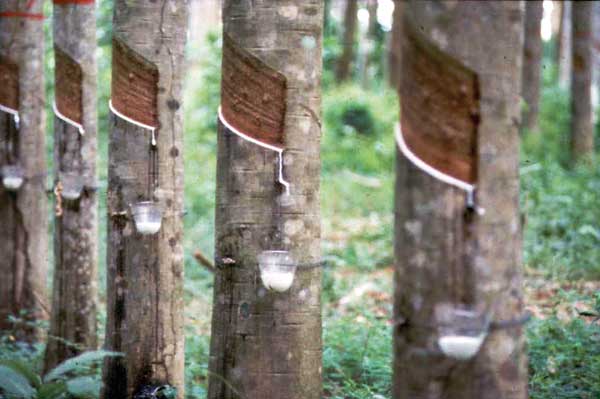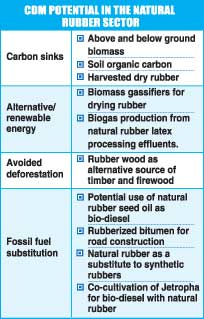Reply To:
Name - Reply Comment
By Dr. N.Yogaratnam
Climate change is considered one of the most serious threats to the global environment. Increasing concentrations in the atmosphere of greenhouse gases (GHGs) such as methane, nitrous oxide, hydro fluorocarbons, per-fluorocarbons, sulphur hexafluoride and most importantly, carbon dioxide have been implicated to be the primary reason for global climate change. International concern about this problem led to the establishment of the Inter-governmental Panel on Climate Change (IPCC) in 1988.
We have been talking about the eco-friendly credentials and carbon sequestration potential of natural rubber plantations, mostly in our own forums, for several years now. But little has been done until now to market the green image of natural rubber for tangible financial gains. With the adoption of afforestation and reforestation sinks for CDM funding under the Kyoto Protocol, there is an opportunity to bring international funding into the natural plantation sector. The magnitude of CDM funding that a natural rubber plantation is theoretically eligible for is far greater than the financial assistance that is available today through the Government of Sri Lanka (GOSL).
It will be in the best interest of both the rubber processors/manufacturers and the rubber planters to attract CDM funding for natural rubber plantations. Agencies interested in the rubber plantation sector need necessarily be represented in future COP negotiations to present the case of natural rubber plantation appropriately and to ensure that the natural rubber plantations come under the CDM of the Kyoto Protocol. The International Rubber Research and Development Board has already realized the importance of the issue and initiated action to seize the opportunity.
.jpg)
The following specific course of action is proposed for bringing natural rubber plantations under the CDM of the Kyoto Protocol:
4Sensitize all the stakeholders, both governmental and non-governmental agencies on the importance and implications of natural rubber plantations coming under the CDM of the Kyoto Protocol.
4Ensure that interests of natural rubber plantations are well represented in all future climate change negotiations under the UNFCCC.
4Take up the issue of natural rubber plantations with international agencies such as IRRDB, IRSG and with the NGOs that are interested in carbon sequestration issues and make use of their help in future COP negotiations.
4There are other parties inside Sri Lanka and in other countries (e.g. teak plantations in Brazil) that are equally interested in getting CDM credits for their plantations. We should have better coordination with them to achieve the common goal of bringing plantations under the CDM.
4Explore for potential buyers for carbon credit from natural rubber plantations in the emerging Kyoto market on a bilateral basis.
4Develop suitable agro-management techniques that will increase in the carbon sequestration by natural rubber plantations, both in the biomass and in the soil.
4Strengthen research efforts in estimating carbon sequestration by natural rubber plantations by refining the methodology by adopting world-class techniques, which will stand strict scrutiny during any future verification for certifiable emission credits.

Implication on NR plantations
The decision by COP 9 has profound implications for the natural rubber (NR) plantation sector. COP 9’s decision speaks about including afforestation and reforestation activities into the CDM of the Kyoto Protocol, but there has been no specific mention about plantations. Although plantation activities have not been directly mentioned in the decisions of COP 9, they are eligible for CDM funding if they meet the general requirements as applicable to afforestation and reforestation and other conditions stipulated for CDM.
Studies show that the carbon sequestration potential of natural rubber trees is much greater than most tree species commonly used in afforestation/reforestation programmes. Studies at the Rubber Research Institute and elsewhere have established the excellent carbon sequestration capacity of natural rubber plantations, which is roughly in the range of 7-9t C per ha per year or more. For example, in India alone, from a total area of about 0.5 m ha of natural rubber in India, we have about 3.5 to 4 mt C for sale in the Kyoto market every year which is 7 to 8 percent of the combined demand for carbon credit by Japan and the European Union (50 mt C per year).
It is generally considered that the cost of sequestering C in developing countries is about US$ 15 per tonne C (which will vary depending on the demand in the carbon market). At this rate, the global rubber plantations taken together have vast potential market value in the Kyoto carbon market. But this market can be tapped only if natural rubber plantation is explicitly included for carbon crediting under the Kyoto Protocol which is now theoretically possible with the decision of COP 9 to include carbon sink from afforestation and reforestation activities under the CDM. Given the fact that rubber plantations are very efficient in sequestering atmospheric carbon dioxide, there is no reason why rubber plantations should be left outside the purview of the CDM mechanism.
Activities related to NR processing also qualify for further funding under the CDM. The effluents produced during NR processing are now used to generate biogas which is used for domestic cooking purposes as well as for drying rubber. Use of biomass gasifiers and the possible use of solar thermal systems for drying rubber are examples of the use of non-conventional energy in the NR processing sector. The use of non-conventional energy in the NR processing sector helps in ‘displacing’ fossil-based fuels which amount to ‘indirect sequestration of carbon’ and therefore qualify for CDM funding.
Rubber wood is increasingly used as a good quality non-forest timber in the construction and furniture industries. The left over rubber wood, which is of an inferior  quality, is used for making particle boards etc. or as domestic or industrial firewood. Thus, rubber wood helps to reduce the pressure on forests for timber and firewood and thus leads to ‘indirect sequestration of carbon’ (see table 1).
quality, is used for making particle boards etc. or as domestic or industrial firewood. Thus, rubber wood helps to reduce the pressure on forests for timber and firewood and thus leads to ‘indirect sequestration of carbon’ (see table 1).
There are over a million households that are directly dependent on natural rubber plantations for their livelihood. Much more is the number of people dependent on natural rubber processing and product making sectors in the country. Natural rubber cultivation has greatly helped to reclaim ecosystems that were severely degraded due to intensive shifting cultivation practiced by the native communities. Community-based natural rubber cultivation can help these people to improve their standard of living and integrate with the main stream society.
Projects implemented under the CDM of the Kyoto Protocol offer opportunity for investors (e.g. Annex B countries) seeking certified emission reduction (in order to offset their own GHG emissions) to invest in developing countries for the dual objects of reducing GHGs and contributing to sustainable development. Natural rubber sector is an ideal case for funding under the CDM of the Kyoto Protocol as part of the LULUCF activities. A future incentive-based carbon abatement project for natural rubber plantations under the CDM will be compatible with the socio-economic and ecological criteria set out under the CDM for sustainable development.
If the entire Global NR industry speaks in unison and wins at the conference of parties for inclusion of the eco-friendly rubber cultivation for aid under the Clean Development Mechanism of Kyoto Protocol, NR plantations can avail themselves of the benefit of vast global funding.
The United Nations Conference on Trade and Development (UNCTAD) had initiated action by a Project Proposal, ‘CDM Challenges and Opportunities in The Rubber Commodity Sector’, which was expected to be completed in eight months, the outcome of it is still unknown.